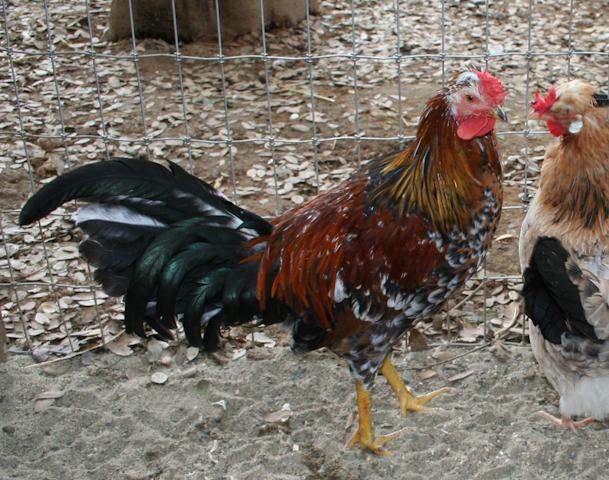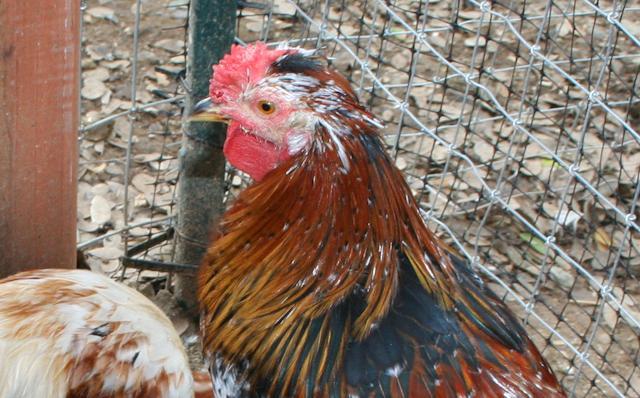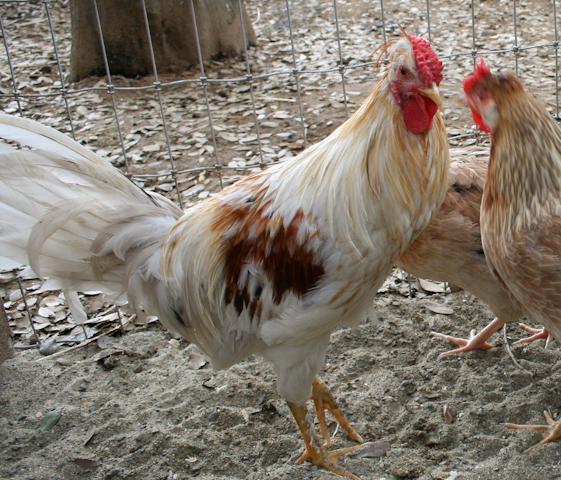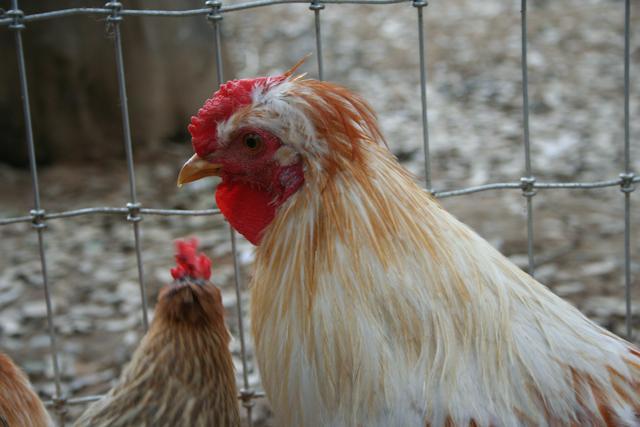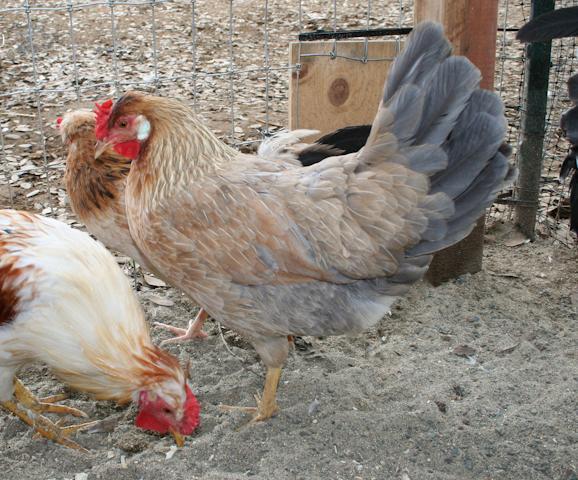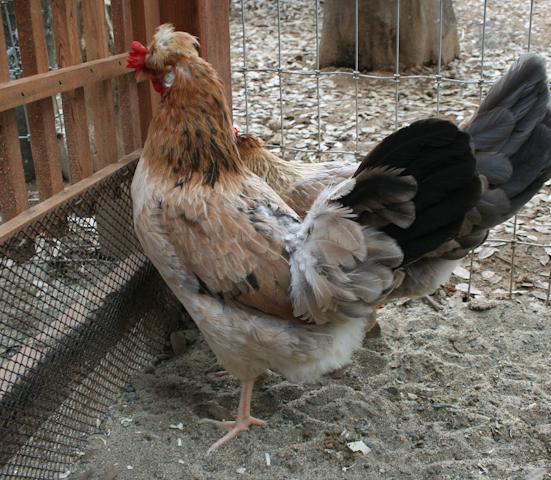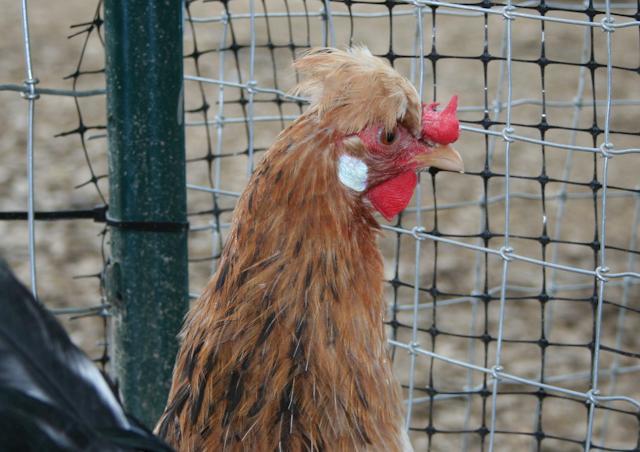Good morning other Mary, nice to see your beautiful grass. We have green but, mostly weeds and some kind of sprawling ground cover. Our week has been cold in am but gorgeous later in the day, think rain is coming back next week. Better than snow.
Navigation
Install the app
How to install the app on iOS
Follow along with the video below to see how to install our site as a web app on your home screen.
Note: This feature may not be available in some browsers.
More options
You are using an out of date browser. It may not display this or other websites correctly.
You should upgrade or use an alternative browser.
You should upgrade or use an alternative browser.
Icelandic Chickens
- Thread starter The Sheriff
- Start date
But, beings cold birds from Iceland how do they do they tolerant the heat?Almost a year ago I became interested in Icelandic chickens. A stray bird flew over our fence and joined our flock. I posted pictures here and was told by a few people that it could be an Icelandic. I did some research and contacted Lyle Behl, the man who imported the first Icelandic chicken hatching eggs into the US in 2003. He verified that it appeared to be an Icelandic to him and told me that he had shipped eggs to California in the past. Well my excitement was dashed a couple of weeks later when she laid a green egg. Icelandic chickens lay white eggs. My Icelandic was crossed with an EE!
By this time I was hooked and I wanted to be part of the effort to save the Icelandic chickens. They were nearly extinct in Iceland since the 1950's when commercial poultry producers imported breeds more conducive to egg production and eating. In the 1970's a veterinarian with the Agricultural School of Iceland singlehandedly saved the Icelandic chicken from extinction. Even now, there are fewer than 3,000 of these birds in Iceland but there is an ongoing effort to save them. I learned everything I could about Icelandic chickens and communicated with Lyle Behl. He put me in contact with people on the West coast to whom he has shipped eggs.
I had the fortune to find Sigrid and Sveinn in southern California. Iceland natives, they are passionate about preserving the chickens of their country. They have imported hatching eggs on three trips to Iceland since Lyle hatched the first 11 chicks in 2003. I told Sigrid about my interest in joining the cause, but she didn't make it easy. I think getting accepted into my registered nursing program was easier than getting my hands on an Icelandic hatching egg. We had many conversations and written exchanges before Sigrid decided I was worthy. All I expected was a few hatching eggs but that wasn't to be. Instead, Sigrid and Sveinn gifted me with two Icelandic hens and two Icelandic roosters! I had not seen pictures of them and kind of assumed that they would be the ugly ducklings of her flock but I was still so excited about getting them. After much ado and worry they arrived last night and I went to the post office hub at 10 p.m. to pick them up.
When I opened the box I literally cried. They were the most gorgeous birds I had ever seen. I knew from my research and conversations with Sigrid that they were colorful and unique, often with crests on their heads. Sigrid says hatching an Icelandic chicken is always like winning a lottery. You never know what you are going to get. They can and do look completely different from the parents. I spoke with Sigrid this morning and she told me that my hens came directly from the veterinarian who saved them from extinction. My roosters came from a remote area off the Northeast corner of Iceland. She brought the eggs back with her this fall and they hatched October 23, 2009. I now have one of the most genetically diverse flocks of Icelandics in the United States, OVERNIGHT!
I did not pay for my birds nor will I pay for hatching eggs from Sigrid. Instead I will donate money to the Protective Society for the Icleandic Chickens in Iceland. Any future profit I make from the sale of hatching eggs and birds will go there as well. I am really excited about my new venture and just had to share it with my BYC friends. Here are pictures of my flock of Icelandic chickens:
Here they are being introduced to Annie:

This is Orri, which is a name for male poultry in Old Icelandic. He is almost four months old.


This is Isi, (pronounced Icee). He too is almost four months old.


This is my 11 month old hen, Lukka, meaning lucky in Icelandic.


This is Henna, for the hair color! She is 12 months old.


If you have read this far, THANK YOU! I guess you can tell I am excited.
Edited to add that the importation of the hatching eggs was done legally with the required permits, blood testing, inspections, etc. But after recent changes in airline security it may be more difficult, if not impossible to do.
- Apr 10, 2014
- 109
- 1
- 76
This comment is about a week late, but I ordered from Whipporwill Farms and was very pleased. I ordered 12, was sent 18, 17 of which arrived in great exterior shape, and hatched 13! Great diversity! From WI to SC. I ordered from the other seller I see pretty often on ebay, too. Ordered 6, received 7, hatched 4, and all 4 chicks looked super similar.I had 2 pullets that looked very nearly identical at 2.5 months old. I sold one with a cockerel to a friend. I wouldn't feel comfortable ordering from that seller again just due to the lack of genetic diversity. Could have been a fluke, I guess.
Ok. I sold 3 cockerels and 1 pullet of my 17. I have 5 cockerels and 8 pullets now. I am 95% sure I will let 2 other cockerels go, but I can't stand the thought of not keeping the other 3. Haha
Does anyone clip wings? 3 of my 13 are about 30 feet up in a tree tonight. I couldn't get them to move. Super worried about owls.
I couldn't get them to move. Super worried about owls.
Ok. I sold 3 cockerels and 1 pullet of my 17. I have 5 cockerels and 8 pullets now. I am 95% sure I will let 2 other cockerels go, but I can't stand the thought of not keeping the other 3. Haha
Does anyone clip wings? 3 of my 13 are about 30 feet up in a tree tonight.
 I couldn't get them to move. Super worried about owls.
I couldn't get them to move. Super worried about owls.
Last edited:
You are off to a good start LittleChickSpy. No, I have never clipped wings.
Iceland is a temperate climate, not cold like you would think from the name. They do fine in the heat, mine have dealt with temps up to 115. People in Arizona have kept them as well.But, beings cold birds from Iceland how do they do they tolerant the heat?
I thank you for your information on this. Good to know. As the MotherEarth said they need roaming space not in a pen or little run. Also, they said they like to fly? Is that so?Iceland is a temperate climate, not cold like you would think from the name. They do fine in the heat, mine have dealt with temps up to 115. People in Arizona have kept them as well.
I hear they are great escape artists - if there is any way out, they will find it fast.
I hear they are great escape artists - if there is any way out, they will find it fast.
Yep. They are good flyers. They will test the boundaries and show you where your coop is weak. They love roosting in rafters, so if you don't want that, you'd better block that area off. They would not do well in a confined area, they need a good amount of room.
Hi Kelly hope the fires are no longer a threat
Yes, they are good flyers for chickens. Unless you have a secure covered run, they will be out wandering about.
New posts New threads Active threads
-
Latest threads
-
Crop impaction after care
- Started by Chickenladymay
- Replies: 0
-
Area around eye looks weird suddenly
- Started by Tervuren
- Replies: 0
-
-
-
Scaly leg mites and ivermectin
- Started by Hmenzi
- Replies: 1
-
-
Threads with more replies in the last 15 days
-
Introducing TUDYBOOK - The Tudy Coloring Book Generator
- Started by Nifty-Chicken
- Replies: 70
-
Open Contest TudyBook Holiday Dreams, a Text-to-Image Contest
- Started by Debbie292d
- Replies: 46
-
-
Question of the Day - Sunday, December 21st, 2025
- Started by casportpony
- Replies: 44
-
-
×


